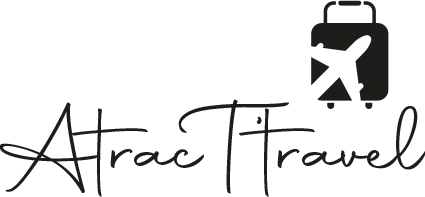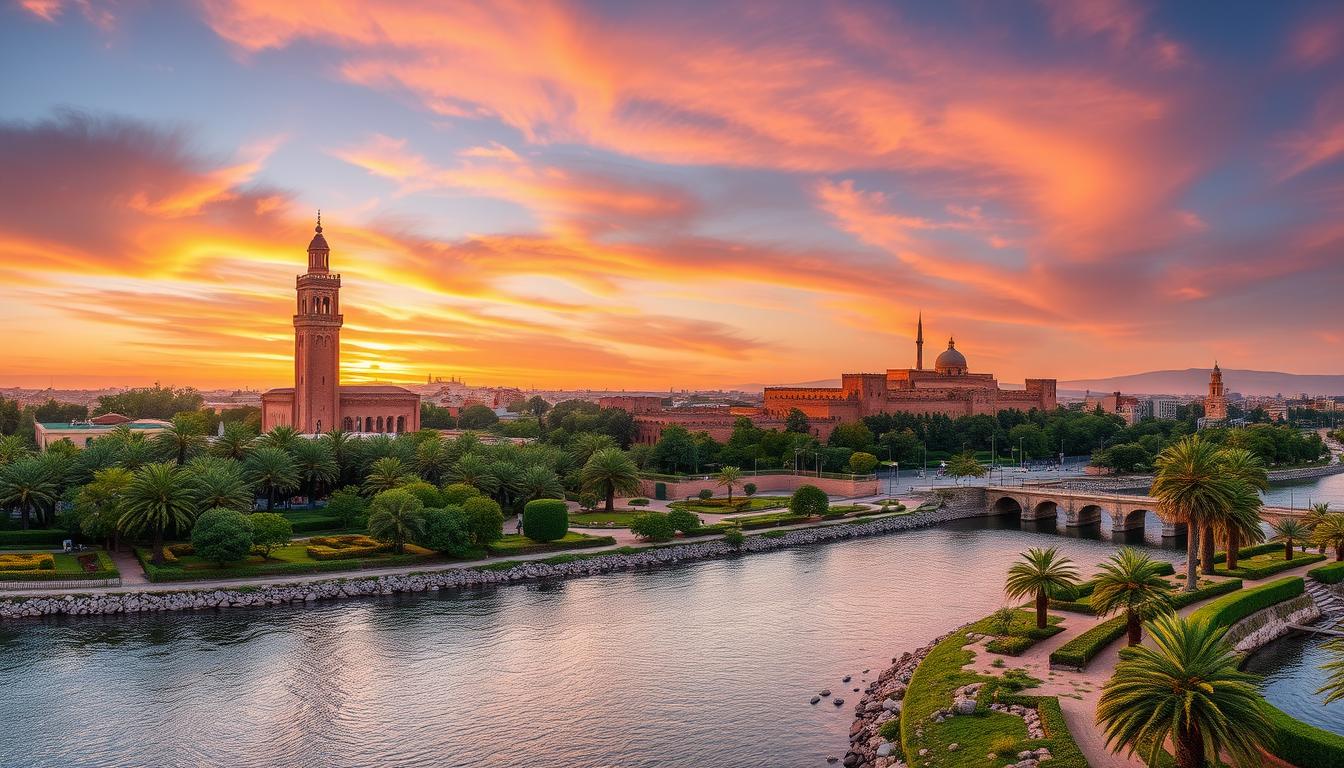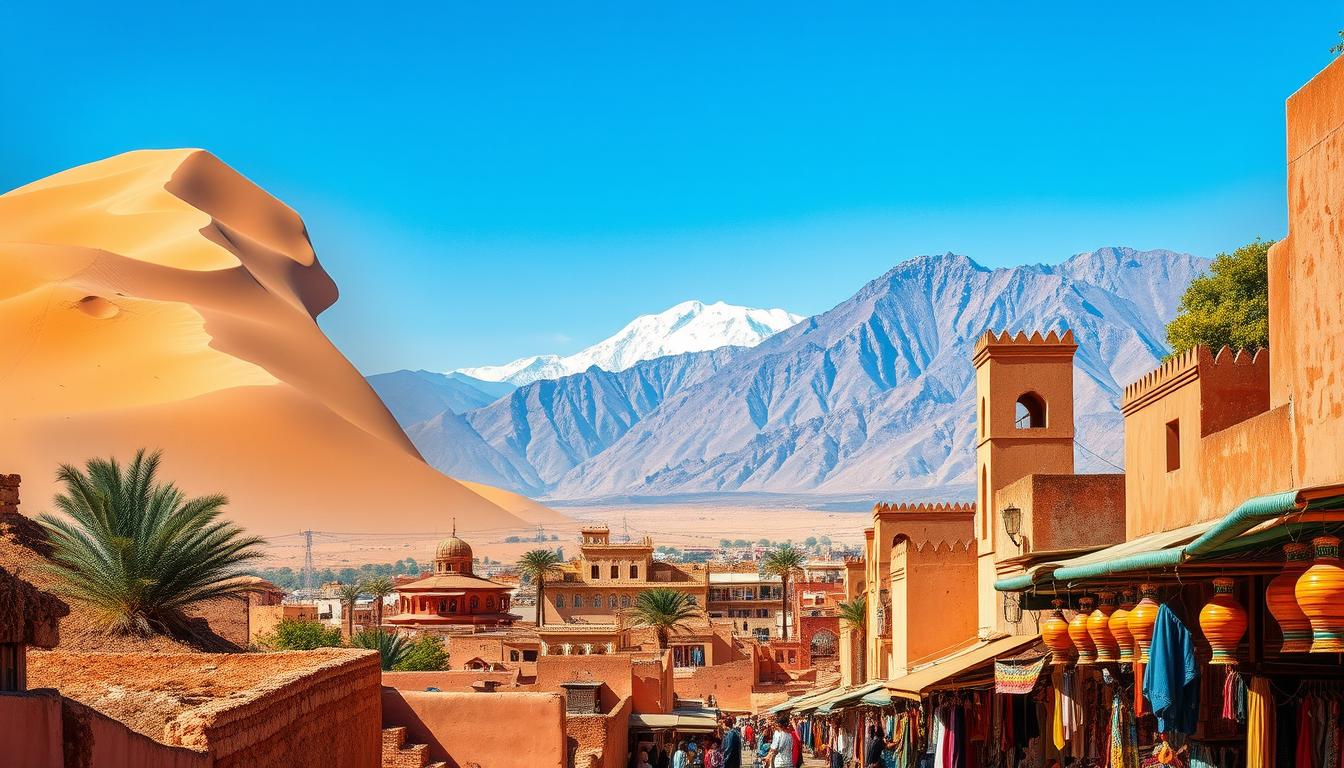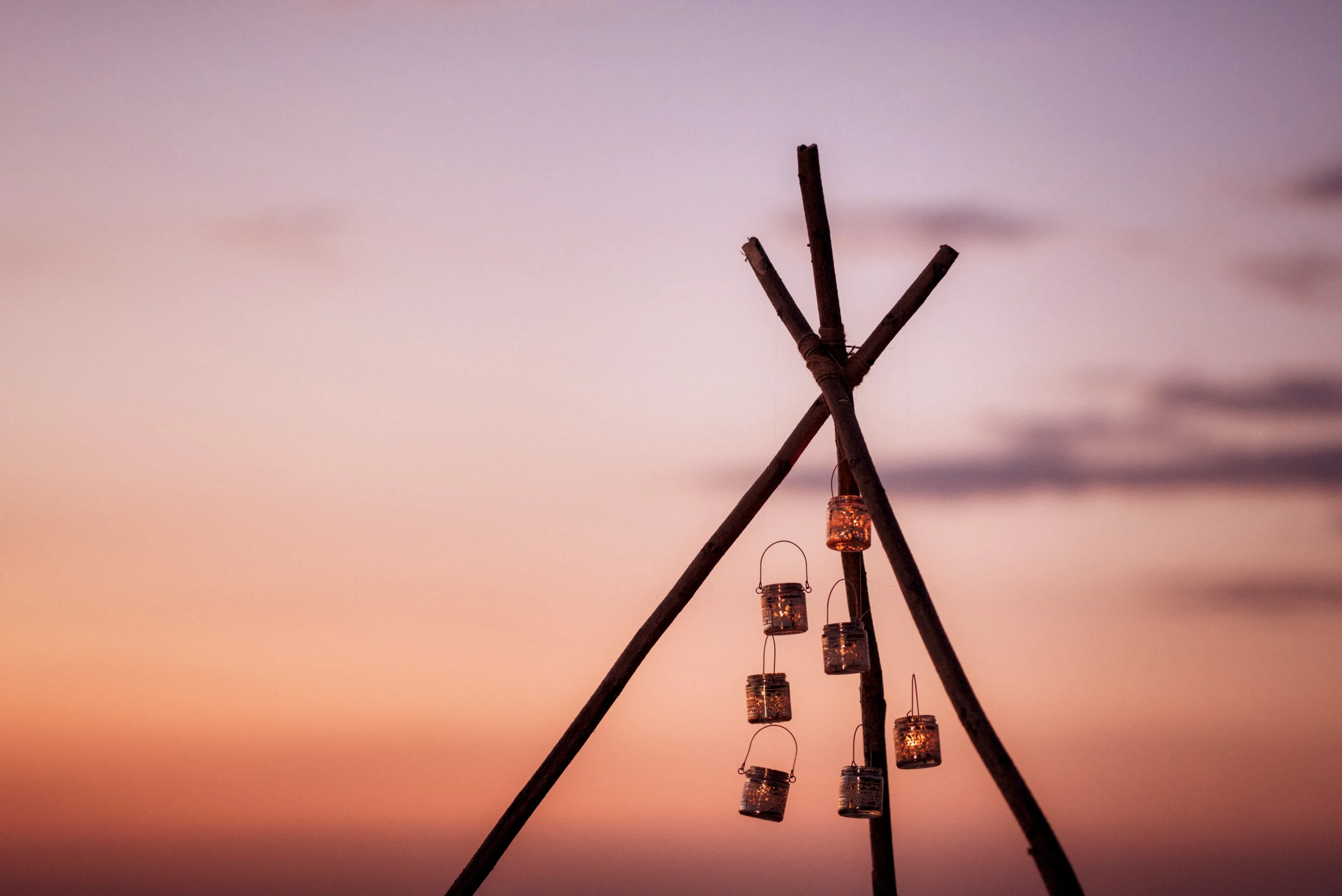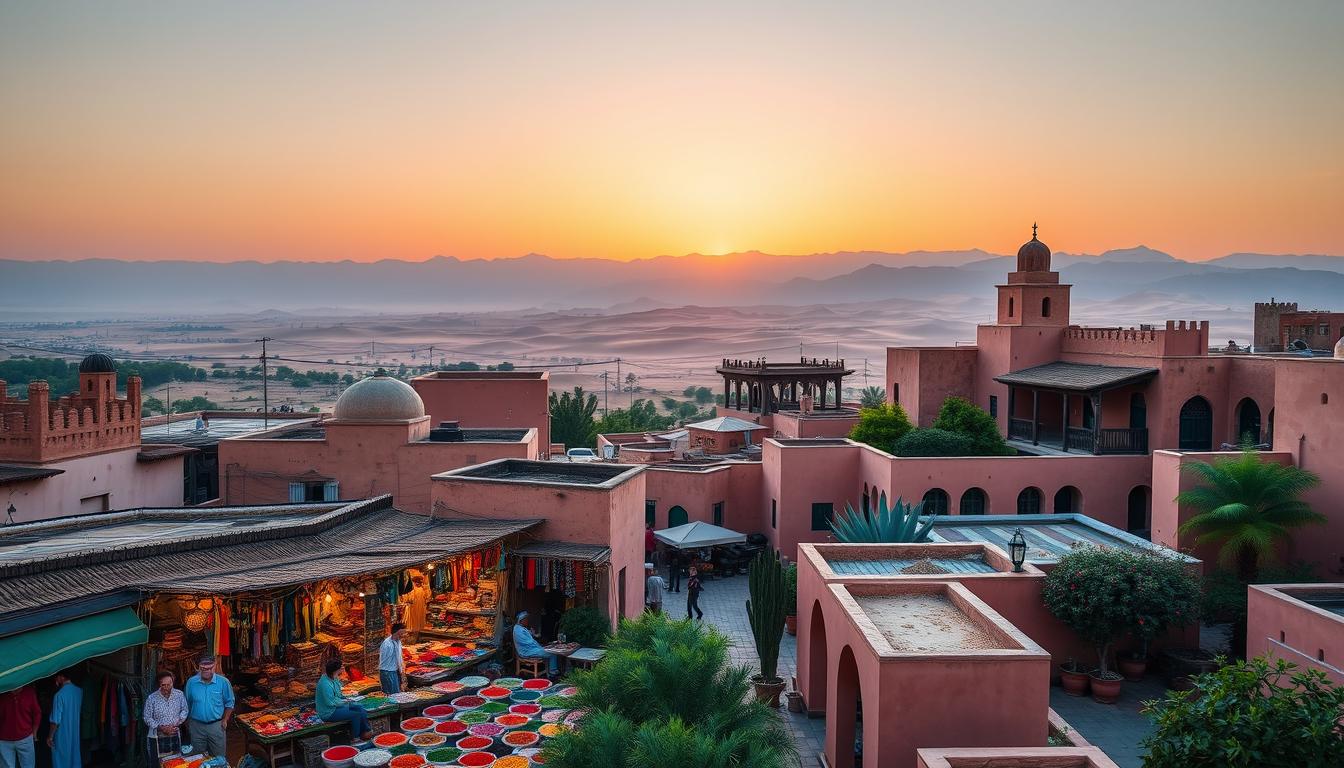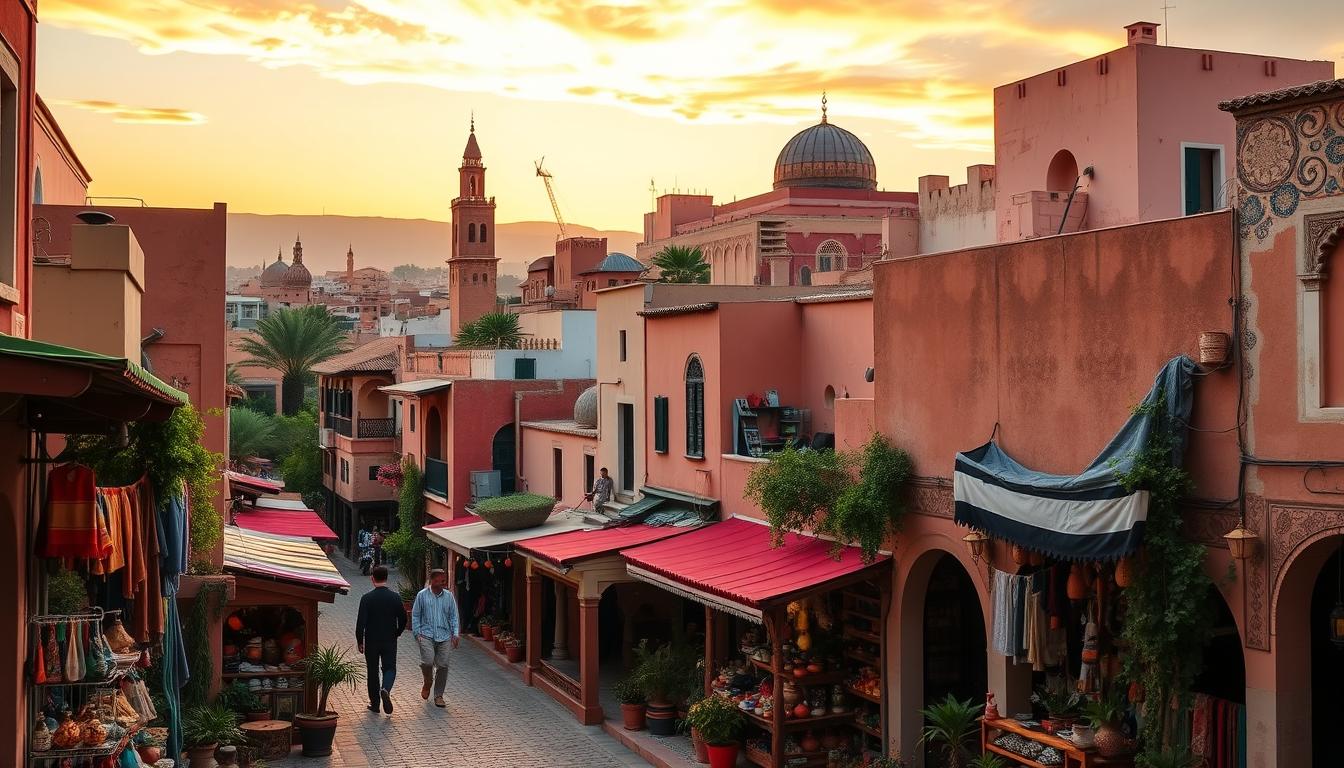Key Takeaways
- Rabat is the official capital city of Morocco in Africa
- The city offers a perfect blend of historical and modern experiences
- UNESCO World Heritage sites are prominent in Rabat
- Unique cultural diversity defines the Moroccan capital
- Travelers can explore both traditional and contemporary attractions
Introduction to Rabat: The Heart of Morocco
Rabat, Morocco’s capital, is a vibrant city on the country’s Atlantic coast. It seamlessly blends old-world charm with modern flair, offering a unique glimpse into Morocco’s rich culture and heritage. Walking through Rabat, you see where old meets new. It’s a key spot for politics and culture. Exploring Morocco’s capital shows you its deep history.“Rabat is not just a city, it’s a living museum of Moroccan heritage.” – Local Historian
- Coastal metropolis with stunning Atlantic views
- Political center of the Kingdom of Morocco
- Blend of Islamic and European architectural influences
- UNESCO World Heritage site with remarkable historical sites
Historical Significance of Rabat
Rabat is a city with a rich history that spans centuries. It has seen the rise and fall of many civilizations. Each one has left its mark on the city’s culture and landscape.The Foundation of the City
Rabat began in the 12th century with the Almohad dynasty. It was a strategic settlement. Key moments in its history include:- 12th century: Initial settlement by Almohad rulers
- 17th century: Became a key naval base
- 1912: Became the administrative capital under French rule
- 1956: Confirmed as Morocco’s capital after gaining independence
Architectural Landmarks
Rabat’s buildings show its rich history. The city has structures from different times and cultures.| Landmark | Historical Period | Significance |
|---|---|---|
| Hassan Tower | 12th Century | Unfinished mosque showing Almohad ambition |
| Kasbah of the Udayas | 17th Century | Fortified citadel with Andalusian style |
| Royal Palace | Modern Era | Symbol of modern Moroccan governance |
“Rabat is not just a city, but a living museum of Moroccan history and culture.” – Moroccan Cultural HistorianEvery stone in Rabat has a story. It’s about resilience, cultural exchange, and innovation. Exploring this city, you’ll uncover the history that shaped Morocco.
Cultural Diversity in Rabat
Rabat is a vibrant city in Africa that shows a unique mix of cultures. It’s a place where Berber and Arab traditions come together. This creates a rich cultural experience for those visiting.The Fusion of Berber and Arab Influences
Rabat’s culture is shaped by both Berber and Arab traditions. This mix is seen in:- Architectural styles blending Moorish and traditional Berber designs
- Language mixing Arabic dialects with Amazigh (Berber) expressions
- Traditional clothing that combines Arab and Berber textile techniques
“In Rabat, every street tells a story of cultural convergence.” – Local Cultural Historian
Festivals Celebrated in Rabat
Rabat’s festival calendar shows the city’s diverse culture. Visitors can enjoy lively celebrations that highlight the region’s cultural identity.| Festival Name | Cultural Significance | Month |
|---|---|---|
| Mawazine Festival | International Music Event | May-June |
| Eid al-Fitr | Islamic Religious Celebration | Varies |
| Rabat Traditional Arts Festival | Berber Cultural Showcase | October |
Must-Visit Attractions in Rabat
Rabat, Morocco’s capital, is a treasure trove of history and culture. It’s a place where ancient grandeur meets modern charm. As you wander through this lively city, you’ll find landmarks that tell the story of Rabat’s rich heritage.The Royal Palace: A Regal Masterpiece
The Royal Palace is a stunning example of Moroccan architecture. Though you can’t go inside, the outside is a feast for the eyes. Its detailed tiles and grand design are truly awe-inspiring.- Location: Heart of Rabat’s administrative district
- Architectural Style: Moroccan Islamic design
- Significance: Official residence of the Moroccan monarch
Hassan Tower: A Historical Monument
The Hassan Tower is a symbol of Rabat’s history. Started in the 12th century, it’s a massive minaret that connects you to the city’s past.“The Hassan Tower represents the dreams and artistic vision of a bygone era.” – Moroccan Architectural Journal
The Kasbah of the Udayas: A UNESCO World Heritage Site
The Kasbah of the Udayas is a gem by the Bou Regreg River. Its blue and white walls are perfect for photos and exploring. It’s a window into Morocco’s history.| Feature | Description |
|---|---|
| Architectural Period | Andalusian-Moorish design |
| UNESCO Status | World Heritage Site |
| Key Attractions | Traditional gardens, historic gates, panoramic views |
Mohammed VI Museum of Modern and Contemporary Art
The Mohammed VI Museum is a must-see for art lovers. It features works by Moroccan and international artists. It’s a window into Morocco’s vibrant art scene.- Established: 2014
- Collection: Over 900 artworks
- Focus: Modern Moroccan and international contemporary art
Enjoying Nature in Rabat
Rabat, the Moroccan capital in North Africa, is a mix of city life and nature. The city’s parks offer calm spots away from the city’s noise. They invite visitors to see its peaceful natural spots.The Andalusian Gardens
The Andalusian Gardens are a stunning oasis in the heart of Rabat, Morocco’s capital. Featuring a wide range of Mediterranean plants, these gardens offer a peaceful retreat where visitors can unwind and enjoy the city’s natural beauty.- Exotic palm trees and fragrant citrus plants
- Carefully manicured walking paths
- Elegant fountains and classical architectural elements
“The gardens represent a living testament to Rabat’s rich horticultural heritage.” – Local Landscape Historian
Riverside Experiences along Bou Regreg
The Bou Regreg River connects Rabat with Salé. It offers many activities that show off the area’s beauty.| Activity | Description | Duration |
|---|---|---|
| Boat Tours | Scenic river cruises | 1-2 hours |
| Riverside Walks | Scenic pedestrian paths | Flexible |
| Photography | Capture stunning urban and natural landscapes | Self-paced |
Local Cuisine: A Taste of Rabat
Rabat, a top tourist spot in Morocco, is a food lover’s dream. The city’s food scene is a mix of old traditions and new flavors. Exploring Rabat’s food scene is like entering a world of amazing tastes and smells. It truly captures the spirit of Moroccan food.Traditional Moroccan Dishes
Rabat is known for its iconic dishes that show the soul of Moroccan cooking:- Tagine – A slow-cooked stew made in a special clay pot
- Couscous – A grain dish often served with veggies and meat
- Pastilla – A pastry filled with spiced meat
“Food is the heart of Moroccan culture, telling stories of tradition and connection.” – Local Rabat Chef
Popular Street Food
Street food in Rabat is a true taste of local flavors. You’ll find many tasty options that show Morocco’s food diversity.| Street Food Item | Description | Price Range |
|---|---|---|
| Msemen | Flaky square pancake | 1-3 MAD |
| Harira | Traditional soup | 5-10 MAD |
| Merguez | Spicy lamb sausage | 10-15 MAD |
Shopping in Rabat
Rabat offers a unique shopping experience. It captures the essence of this political center and historical city. As you explore the vibrant markets and artisan workshops, you’ll discover a shopping journey that goes far beyond simple purchasing.Discovering Rabat’s Traditional Souks
The city’s traditional markets provide an immersive experience into Moroccan culture. You’ll find yourself wandering through narrow alleys filled with colorful stalls. Each stall offers a glimpse into local life. Some highlights include:- Authentic handwoven textiles
- Intricate metalwork
- Traditional ceramics
- Handcrafted leather goods
“Shopping in Rabat is like stepping into a living museum of craftsmanship” – Local Artisan
Local Craftsmanship and Artisan Art
The artisan workshops in Rabat showcase extraordinary skills passed down through generations. As a historical city, Rabat preserves unique artistic traditions. Artisans specialize in:- Detailed woodcarving
- Sophisticated jewelry making
- Traditional carpet weaving
- Intricate metalwork
Getting Around Rabat
Exploring Rabat, the capital of an African country, is an exciting journey. Knowing how to get around makes it easier and more fun.Public Transportation Essentials
Rabat has many ways to get around the city. You can use buses and trams to reach important places and attractions.- Tram Network: Covers major city routes
- Bus Services: Extensive citywide coverage
- Affordable ticket prices
- Frequent operating schedules
Tram and Bus Details
| Transportation Type | Average Cost | Coverage |
|---|---|---|
| Tram | 5-10 MAD | City Center & Suburbs |
| City Bus | 4-7 MAD | Wider Metropolitan Area |
Walking Tours: Discovering Rabat
Walking is a great way to see Rabat’s culture. The city center is small, making it easy to explore on foot.“Rabat’s streets tell stories of centuries past, waiting to be discovered by curious travelers.” – Local Tourism Guide
- Guided walking tours available
- Recommended routes through historical districts
- Free walking maps at tourist information centers
Accommodation in Rabat
Finding the right place to stay in Rabat can make your trip better. The city has many places to stay, from fancy hotels to cozy guest houses. There’s something for everyone, no matter your budget or what you like. Choosing where to stay in Rabat can really improve your trip. Think about these things when picking your place:- How close it is to sights you want to see
- How much you can spend
- The amenities you need
- Wanting a real Moroccan experience
Luxury Hotels: Comfort and Elegance
If you want the best, Rabat’s luxury hotels are top-notch. They offer:- Amazing views of the ocean or city
- Top-notch spa treatments
- Great food to eat
- Excellent service
Budget-Friendly Stays: Smart Traveling
Even on a tight budget, Rabat has good places to stay. These spots have clean rooms and the basics you need.| Accommodation Type | Price Range | Average Amenities |
|---|---|---|
| Hostels | $10-$30/night | Shared rooms, free Wi-Fi |
| Budget Hotels | $30-$60/night | Private rooms, breakfast included |
| Guesthouses | $40-$80/night | Local charm, personalized service |
Unique Guest Houses: Authentic Experiences
For a real taste of Morocco, try a guest house in Rabat. These places show off local culture and offer a cozy stay.“Staying in a Rabat guest house is like discovering a hidden gem in the heart of Morocco.” – Travel EnthuasiastNo matter where you stay in Rabat, you’ll have a great time. The city’s warmth and hospitality will make your visit unforgettable.
Rabat’s Vibrant Nightlife
When the sun goes down, Rabat turns into a lively place. It shows a new side of itself. The city’s nightlife is a mix of old charm and new fun, making it a favorite spot for evening fun.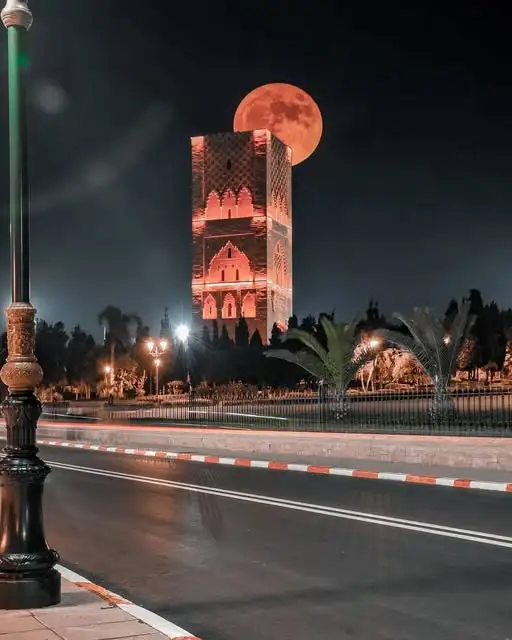
Trendy Bars and Lounges
Check out the city’s top spots for a night to remember:- Sophisticated rooftop bars with amazing views
- Intimate cocktail lounges with Moroccan style
- Modern wine bars with a wide selection
Cultural Events After Dark
Rabat lights up with fun events that celebrate its culture:| Event Type | Description | Location |
|---|---|---|
| Music Performances | Traditional Andalusian and modern Moroccan music | Mohammed V Theater |
| Art Exhibitions | Evening gallery openings with local and international artists | Contemporary Art Spaces |
| Cultural Festivals | Seasonal evening events celebrating Moroccan heritage | Various City Venues |
“Rabat’s nightlife is a delicate dance between tradition and modernity, something for every traveler.” – Local Cultural ExpertLooking for a quiet night or a lively one? Rabat’s nightlife has it all. It promises a memorable time in this North African gem.
Art and Museums in Rabat
Rabat, a historical city in Morocco, has a lively art scene. It shows the change in culture. The museums and art spaces give visitors a peek into Moroccan art. The art journey in Rabat is more than just shows. The museums mix old and new art. They show the complex culture of the region.Key Museums to Explore
- Mohammed VI Museum of Modern and Contemporary Art
- National Museum of Photography
- Borj Sidi Abdelaziz Museum
- Moroccan Museum of Antiquities
Local Artists Making an Impact
Local artists in Rabat mix old Moroccan ways with new ideas. They push cultural limits and share new stories through their art.“Art in Rabat is a conversation between history and innovation” – Local Art Curator
- Hassan El Glaoui – famous painter
- Fatima Meziane – modern visual artist
- Ahmed Cherkaoui – key abstract painter
Day Trips from Rabat
Rabat, Morocco’s political center, is a gateway to amazing adventures. Beyond the city, you’ll find stunning landscapes and lively cities. This journey will change your travel experience for the better. Exploring around Rabat gives you a fresh view of Moroccan culture and nature. You’ll find places that add to your city adventures.Exploring Nearby Cities
Several amazing cities are just a short trip from Rabat:- Salé: A historic city across the Bou Regreg River
- Casablanca: Morocco’s biggest economic center
- Kenitra: A charming coastal town with a rich history
“Travel is about experiencing the unexpected and embracing local nuances.” – Moroccan Traveler’s Wisdom
Natural Wonders in the Surrounding Area
Nature lovers will love the diverse landscapes around Rabat:- Atlantic Coast beaches with breathtaking ocean views
- Mamora Forest: A pristine woodland
- Zemmour National Park: Home to incredible biodiversity and scenic views
Safety Tips for Travelers in Rabat
Exploring Rabat, the capital of Morocco, needs careful planning and awareness. This city is vibrant and welcoming to travelers. But, it’s key to keep your safety and well-being first. Traveling in Rabat can be amazing if you’re careful. Your safety begins with being alert and ready for your adventure in this lively capital city.Staying Aware in Urban Spaces
- Keep your belongings close in crowded areas
- Avoid displaying expensive jewelry or electronics
- Stay in well-lit and populated streets during evening hours
- Use official taxi services or recommended transportation
- Dress respectfully to blend in with local customs
“Awareness is your best travel companion in Rabat” – Moroccan Travel Guide
Emergency Contacts
Before you explore Rabat, save these important emergency numbers:- Police: 190
- Ambulance/Medical Emergency: 150
- Tourist Police: +212 537 70 89 20
- United States Embassy: +212 537 63 62 00
Seasonality and Best Times to Visit Rabat
Planning your trip to Rabat, Morocco’s capital, means knowing the city’s seasons. Each time of year brings its own charm, making when you go very important. Rabat’s weather changes with the seasons, giving travelers many chances to explore. The city’s mild Mediterranean climate makes it appealing all year round.Weather Considerations
How you experience Rabat depends a lot on the season:- Spring (March-May): Mild weather, great for seeing the outdoors
- Summer (June-August): Warm and dry, perfect for enjoying the sun
- Autumn (September-November): Comfortable and fewer tourists
- Winter (December-February): Cool, sometimes rainy, with temperatures around 10-18°C
Events and Festivals by Season
Rabat’s cultural scene shines through its festivals all year:- Spring Festival of Roses (April)
- Rabat International Film Festival (Summer)
- Mawazine World Rhythms Festival (May-June)
- Traditional Music Festival (October)
“Timing your visit to Rabat can transform a simple trip into an extraordinary cultural journey.” – Moroccan Travel ExpertsEvery season in Rabat offers something special, making your trip unforgettable.
Sustainable Tourism in Rabat
Rabat, a top tourist spot in Morocco, is at the forefront of green travel. Now, visitors can see this historic city without harming the environment. They can also help local communities.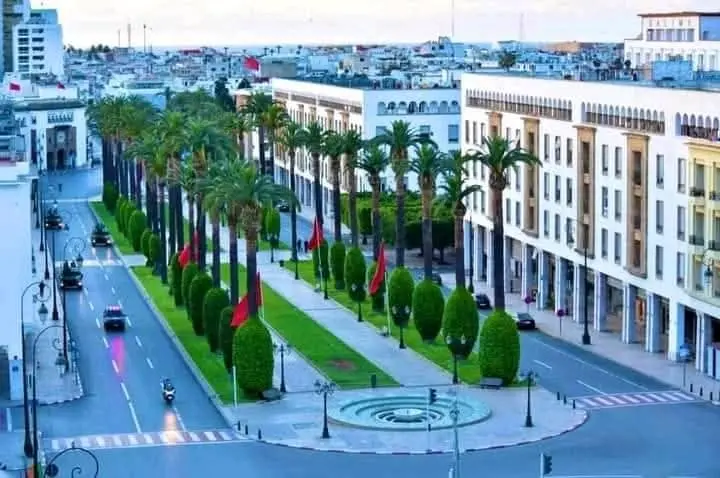
Eco-Friendly Practices
- Use electric public transportation to reduce carbon emissions
- Participate in city walking tours that minimize transportation footprint
- Choose accommodations with green certifications
- Support restaurants using locally sourced ingredients
| Initiative | Impact |
|---|---|
| Water Conservation Programs | Reduces strain on local water resources |
| Waste Reduction Strategies | Minimizes plastic and organic waste |
| Solar Energy Adoption | Promotes renewable energy use |
Supporting Local Communities
Responsible tourism is more than just being green. Rabat lets you help local artists and communities:- Take guided tours led by local experts
- Purchase handicrafts from traditional markets
- Participate in community-based cultural experiences
- Stay in locally owned accommodations
“By choosing sustainable tourism, you become a partner in preserving Rabat’s cultural and natural heritage.”Your smart travel choices help the local economy and protect the environment. This makes a big difference in this amazing place in Morocco.
Conclusion: Why Rabat Should Be Your Next Destination
Rabat is a remarkable historical city that shows Morocco’s vibrant spirit. It’s the African country capital, blending rich culture with modern life. Your trip to Rabat offers unique experiences that go beyond usual tourist spots. The city’s charm is in its mix of old and new. You can see ancient sites like the Kasbah of the Udayas and modern art at the Mohammed VI Museum. Every street and landmark has a story of culture and creativity.Reflecting on Your Experience
Your visit to Rabat will stay with you forever. The warm welcome, tasty food, and stunning buildings make it unforgettable. Explore Rabat’s neighborhoods, join local traditions, and find its hidden treasures.Encouraging Future Visits
Think about coming back to Rabat again and again. Each season brings something new, from spring’s mild weather to lively festivals. Your first visit will make you want to see more of this amazing place.FAQ
What makes Rabat the capital of Morocco?
Rabat is Morocco’s political center, becoming the official capital in 1912. It’s different from Casablanca, which is the economic hub. Rabat has the royal palace, government offices, and diplomatic missions, making it Morocco’s administrative heart.
How old is the city of Rabat?
Rabat’s history goes back to the 12th century. But it officially became a capital in 1912 during the French protectorate. The city has layers of history, with evidence of Phoenician, Roman, and medieval Islamic civilizations.
Is Rabat a good tourist destination?
Yes! Rabat is a top spot in North Africa. It offers historical landmarks, cultural experiences, and modern comforts. You’ll find UNESCO sites, museums, gardens, and a mix of old and new Moroccan culture.
What are the must-visit attractions in Rabat?
Must-sees include the Hassan Tower, the Royal Palace, and the Kasbah of the Udayas. Also, the Mohammed VI Museum of Modern and Contemporary Art, and the Chellah Necropolis. Each place gives a peek into Morocco’s rich history and culture.
What is the best time to visit Rabat?
Spring (March to May) and autumn (September to November) are the best times. The weather is mild and comfortable, with temperatures between 15-25°C (59-77°F).
How safe is Rabat for tourists?
Rabat is one of Morocco’s safest cities. As the capital, it has a strong police presence and welcomes tourists. Just stay alert and take usual precautions.
What language do people speak in Rabat?
Arabic and French are the main languages in Rabat. Many also speak Berber dialects. Tourists will find English spoken in the tourism industry, making communication easy.
What is the local cuisine like in Rabat?
Rabat’s cuisine is amazing, with dishes like tagine, couscous, and pastilla. The city’s food reflects Morocco’s rich culture, blending Berber and Arab flavors.
How do I get around Rabat?
Rabat has a good public transport system, including buses, trams, and taxis. The city is also walkable, making it easy to explore. For longer trips, the metro or taxis are affordable and convenient.
What should I know about cultural etiquette in Rabat?
Dress modestly, respect local customs, and be mindful of Ramadan practices. Greet people with a handshake or nod, and ask permission before taking photos. These actions show respect for the local culture.
